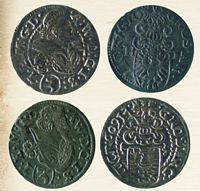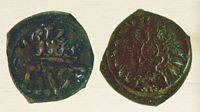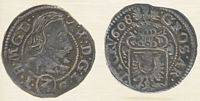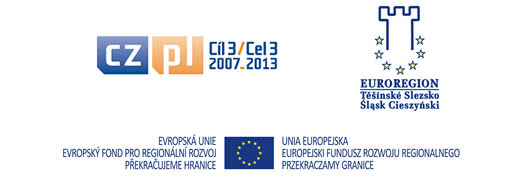Artisans and counterfeiters in Cieszyn
Jahns’ work in Cieszyn came to an end in 1608. According to the custom of mint masters he travelled to other towns among them Nysa where he ran the mint of Archduke Charles, the bishop of Wrocław. The Cieszyn Prince leased the right to mint in Cieszyn to Hans Thacke who also came from Goslar and who was supposed to have been a baker’s apprentice. He had previous experience, having worked in 1598 in Poznań. With the coming of Thacke higher denomination coins began to be struck again in Cieszyn. He most probably employed a different craftsman to make the dies for him since the coins dating from that time are definitely much better made. This applies in particular to thalers, which had been the largest, heaviest and clearly the most expensive type of European silver coinage since the 16th century. Thalers struck by Thacke are 41 mm in diameter and weigh 28.6 g. The obverse bears a waist length portrait of the Prince with a full beard, in ceremonial robes with a wide collar and shawl draped around him. In his right hand the Prince holds a staff or cane resting against his side while in his left hand he holds a plumed hat. The legend which reads simply ADAMVS.WENCESLAVS.DVX.TESSIN[SIS] is located in a double border; the inner one is broken by the Prince’s head, and the outer is made of a laurel wreath. The reverse bears the beautifully rendered crowned Cieszyn eagle of classic proportions, and the legend within the border of a laurel wreath reads SAPIENTE DIFFIDENTIA.
Prince Adam Wenceslas' 1609 thaler is a very spectacular coin; proved by the prices it commands at auctions. However, it is rather unlikely that it represented the official currency of the Cieszyn Duchy. More probably it was issued for commemorative purposes, as in the case of even bigger coins of much higher value, such as 2 and 3 thaler pieces. A 2 thaler coin of the same design, but with a proportionally higher silver content was minted by Thacke in 1608, and then again in 1609 when a 3 thaler coin was also struck. In 1609 Thacke minted 1 and 3 thaler klippes (in numismatics klippes are coins struck on a square, sometimes hexagonal or octagonal, blank).
In 1609 a half thaler was minted as a klippe. Its obverse bears the bust of the Prince with a moustache, a wide collar and a lion’s head on his shoulder. The carefully struck legend reads ADAMVS.WENCESLAVS. The reverse bears the crowned eagle with a ”crescent” on its breast, placed on a heraldic shield with a coronet above, and the remaining titles; D.G. IN.SIL.TES.E.MA.G.D.
In 1609, a year rich in spectacular Cieszyn coins, Thacke even minted gold 5 and 8 ducat coins which were modelled on the thaler depicting Prince Adam Wenceslas’ bust issued in 1609. Neither of them were in official circulation. They are now exceptional rarities. Even smaller coins minted frequently by Thacke i.e. 3 heller coins of 1610 and 3 kreutzer coins of 1609-1611 seem to be more carefully made and far better struck then the coinage of his predecessors. The 3 kreutzer coins present other versions of the Prince’s portrait, usually with a fashionable high collar. On the issue of 1609 as well as on the half thalers struck then there is a lion’s head lowering menacingly on the Prince’s shoulder, meant to emphasise princely power. The sash typical for the coat of arms of the Lower Silesian Piasts appears again on the eagle’s breast. The 3 kreutzer coin minted in 1610, however, depicts the lion but this time there is no sash on the eagle.
As we can conclude from the catalogue of successful emissions of higher denomination coins the period of Hans Thacke’s work in Cieszyn ought to be considered one of the better ones, if not actually the best period in the history of Cieszyn minting. Nevertheless his career was suddenly cut short in the most tragic way, for on 31st May 1611 Thacke was executed in Cieszyn on a charge of counterfeiting coins. The goldsmith, Joachim, who had prepared dies for counterfeits was accused along with him. The counterfeiting concerned Polish coinage as one may suspect, namely Polish groschens of Sigismund III with a crown, a trefoil and an eagle, issued in 1610. Both of them were punished with all severity of the law. Joachim the goldsmith was led out of the town first. He was blindfolded and made to kneel down. His right hand was first chopped off, following which he was beheaded. Two hours later Hans the mint master was burnt at the stake outside the town. It is recorded that he sought comfort in singing the Psalms of David. And thus the ablest Cieszyn mint master and the man who most probably had made the dies for the mint master’s fine coins met their fate. The details of their counterfeiting are not known, but it might have been connected with a counterfeiting racket organised by Mikołaj Komorowski, the starost of Oświęcim and Nowy Targ, in his Żywiec estates. In 1612 a case against Komorowski’s counterfeiters was tried in Olomouc. Among the defendants was Martin Goldschmidt i.e. the goldsmith (also known as Sachs) who was accused of preparing a die for striking 6 groschen coins for ”Hanstak” i.e. Hans Thacke from Cieszyn and Joachim, the goldsmith. Nonetheless his guilt was not proven and after six months he was released from prison on bail of 1,000 guldens. He owned a house in the town and later became a distinguished Cieszyn burgher. Another burgher, Mates Ber, was also questioned in connection with the counterfeiting.
There is no doubt that counterfeiting took place in Cieszyn. In 1609 Stanisławski, the Polish Royal Treasurer, issued a proclamation in which he warned against counterfeiters overstriking Cracow groschens and turning them into poltoraks i.e. 1 1/2 groschen coins with the mintmark of the Cieszyn Prince. They were worth only 1 groschen instead of 1 1/2 so whoever accepted them risked a significant loss. The Viennese Coin Cabinet possesses a specimen of the Cieszyn poltorak with the bust of Adam Wenceslas underneath which there is a visible mark of the original legend SIG III ... DG REX POL M.D.L referring to Polish groschens. The Silesian Museum in Opava has some Cieszyn counterfeits dating from 1611 and 1614. On the other hand it is difficult to distinguish between deliberate counterfeiting and the minting of poor quality coinage which is then replaced by better; a practice carried out by successive Cieszyn mint masters, no doubt with the princes’ knowledge. The poor quality of Cieszyn coinage was widely deplored, especially by town authorities i.e. in Nuremberg in 1607 in a letter addressed to the Cieszyn Prince. In 1613 the Olomouc town council wrote to Prince Adam Wenceslas saying that without meaning to insult him they felt compelled to mount a Cieszyn heller on the wall of the town hall as an example of a worthless coin and to ban its use.
Obviously neither the complaints nor the discovery and the punishment imposed on Thacke for counterfeiting persuaded Prince Adam Wenceslas to give up minting or change his policy. There proved to be no shortage of people willing to take up this clearly dangerous profession. In 1611 Dietrich Rundt was appointed the new Cieszyn mint master and in the same year he struck a silver thaler with its obverse modelled on the coin issued in 1609; although the Prince holds a staff in his left hand. The reverse bears the Cieszyn Duchy’s coat of arms consisting of a shield and several other heraldic elements. The thaler is 37 mm in diameter, and thus smaller. It was also issued as a klippe. In 1613 Rundt minted a gold 3 ducat coin bearing the Prince’s bust on the obverse and the Silesian eagle accompanied by the motto PATIAR VT POTIAR on the reverse. The 3 kreutzer coins was also issued as a klippe by him. Between 1611 and 1614 Rundt struck a number of 3 kreutzer coins almost identical to those issued by Thacke. At the beginning of his work (1611-12) Rundt also minted 3 heller coins and tiny hellers. Their obverses bear the decorative monogram AW and a coronet, while the reverses feature the Cieszyn eagle.
In 1611 Prince Adam Wenceslas, following the example of his father, developed minting in the Cieszyn Duchy by reopening the princely mint in Skoczów. Between 1611 and 1613 it was run by Christoph Cantor, a mint master who marked his coinage with the monogram CC. The mint in Skoczów issued 3 kreutzer pieces, 3 heller coins and copper hellers which are modelled on corresponding types of coins struck in Cieszyn. For instance 3 kreutzer coins minted in 1611 correspond to the Cieszyn 3 kreutzer coin issued in 1609, differing only in terms of the initials CC. After 1611 another person engaged in the Cieszyn minting was Hans Loss, probably Rundt’s assistant. Loss was born in Svibice near Cieszyn and started his career as a mint master around 1607, to begin with in other towns e.g. Chojnów. When he came to Cieszyn in 1611 both mint masters in Cieszyn and Skoczów struck coins without an assayer, as he recorded later. Loss did not stay in Cieszyn for long since in 1614 he found employment in Nysa under Valentin Jahns. Similarily, Cantor also left Skoczów and from 1617 to 1629 worked in Olomouc, and then in Legnica and Opava. The last recorded coin to date from the times of Prince Adam Wenceslas is a 3 heller coin featuring a splendid orb and a cross. It was struck in 1616 but there is no proof whether the coin was issued by Dietrich Rundt.
Prince Adam Wenceslas also issued a medal bearing his bust and titles on the obverse. On the reverse is the Piast eagle and a motto reading NVSQVAM.TVTA.FIDES (Nowhere can I safely put my trust). The portrait depicts the young Prince clean shaven and resembles his likenesses from coins minted in 1591 and 1592. The medal is most often attributed to Tobias Wolf (born c. 1541 – died after 1606), the famous Silesian medallist, the author of numerous medals of Silesian princes and Polish aristocracy e.g.





















